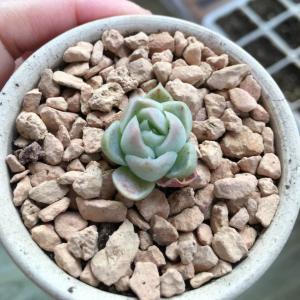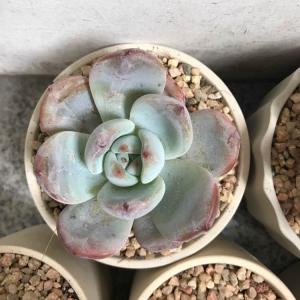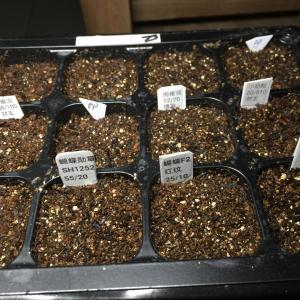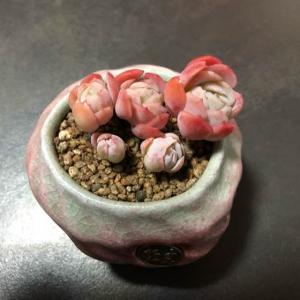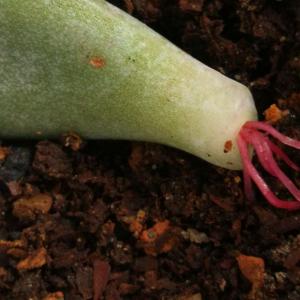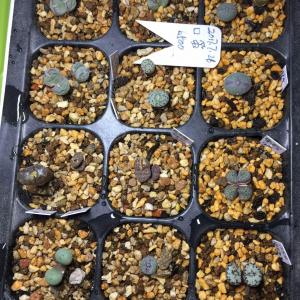文章
Miss Chen
2017年11月24日


生石花为多年生肉质草本。植株具肥大肉质根,但在自然状态下主根很少有侧根,仅在逐渐变细的主根末端有少数须根连有毛细根,当主根折断后会萌发侧根。
根状茎极短,植株卵圆形,高2-3.5厘米。地上部分是两片对生联结的肉质叶,呈倒圆锥体,叶色白、浅灰、棕、蓝灰、灰绿、红、紫红等。叶楔形、半圆形、椭圆形或肾形,对称或不对称。单株叶长18-50毫米,宽13-38毫米,群生植株2-50头。植株顶部具有深色枝状凹陷花纹,称作“视窗”;该属植物叶肉透明,叶片底部富含叶绿体,阳光从视窗进入植株内部并进行光合作用。
植株顶部具一裂缝,深约1-4毫米,裂缝中开花,花单生,雏菊状,花茎2-3厘米,花白或黄色,花期盛夏至中秋。蒴果5-9室,种子黄褐色、淡黄褐色或褐色,有斑点。

生石花的施肥方法
水果皮泡水施肥方法:
此方法适合所有友友,水果中的橘子皮效果最佳,而且制作的方法也非常的简单,在每年的春季与冬季把吃橘子剥下的橘皮收集,切碎,装入瓶子中,在倒入清水,比例约清水3/2,橘皮1/3,然后密封好,在阳光下放置约半个月左右,就可以使用了。一瓶橘子皮水加同样的一瓶清水就可以,约半个月施肥一次即可。
熟腐有机施肥方法:
此肥料可能对大部分友友来说并不好采集,但却是个不错的肥料。
春季时便要采集羊粪,放在背阴的角落,让它自然熟腐,大约到9月或10月就能拿来使用了。施肥时先将盆土挖出1.5厘米至2厘米厚,在把羊粪铺在土壤上,在羊粪上面覆一层厚1厘米的土壤即可,然后浇水,移至放在温暖,阳光充足的地方摆放;若盆直径是10厘米的,可用20克左右的羊粪,若盆直径是20厘米,可用50克左右的羊粪,但若盆更大,羊粪的量也不可过多。
这种肥料有多种好处,尤其对较懒的友友特别有用,羊粪一年用一次,在日常养护中就不用在施肥了;若在开花前期施肥,还能使其花朵艳丽花大;对冬季御寒也有不错的效果。
磷酸二氢钾施肥方法:
此肥料是对表植物表面进行喷施的,但要在9月以后喷施,一直到次年的6月初停止,每隔10天或15天一次。
3
5
Miss Chen:@芮语 加油💪
芮语:谢谢分享,试试看能不能把生石花养肥开花
文章
Miss Chen
2017年11月23日

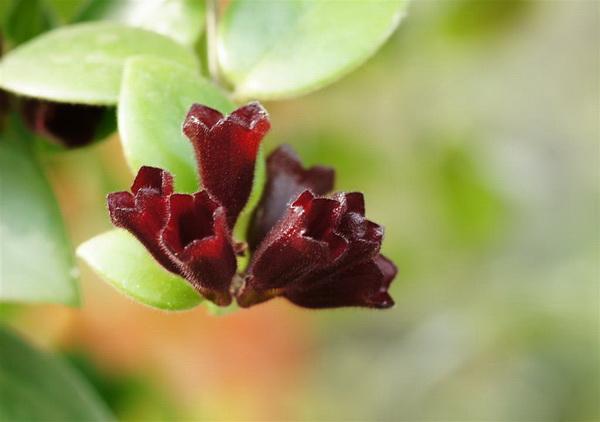
口红花着生小灌木或蔓性植物,一般茎株多纤细状。枝条下垂,长可达30-100厘米。
叶卵形对生,稍带肉质,长4.5厘米,宽3厘米,叶面浓绿色,叶背浅绿色。
花序多腋生或顶生,花萼筒状,暗紫色被绒毛,花冠筒状鲜红色,从花萼中伸出,宛如从筒中旋出的“口红”,管状2唇裂,雄蕊4,长伸至花冠处,子房长型2室。果实含多数种子。在室温适宜的情况下,口红花可在12月至来年2月间开花。

口红花的施肥方法
口红花的施肥频次
口红花需肥量较大,不同生长时期养分配比各有侧重,施肥量与施肥间隔需综合考虑花卉长势及温度、湿度等环境因子。那多久施一次肥呢?
口红花生长茂盛期,约10天至15天施一次肥液,盆土保持湿润状况,盆内勿积水,防止引起烂根。
口红花秋季秋季该怎么施肥
秋季气温逐渐降低,水量和施肥量也随之减少。进入冬季后,口红花生长减缓,需肥量也很少,少施肥后者不施肥,盆土保持干燥。口红花的花期集中在12月至翌年2月,此时期尤其要注意光照时长与磷肥的施用。
掌握口红花的需肥规律
其实施肥不能完全按照计划来,要根据植株的情况,判断口红花确实哪种微量元素,因需施肥。通常情况下,老叶或成熟部位发病或者生长不良,可能是因为氮、钾、镁等移动性好的元素缺失引起的;新叶或茎尖发病,可能是因为缺乏铁、钙、锌等元素;还有一种情况是综合判断,若叶片的边缘及叶脉处出现失绿的现象,是缺少镁和钾。
因此,在营养元素补施时,最好不要只施用单一元素,要结合生产品种的需肥特性及种植经验综合考虑,最终给出较为全面的诊断,进而补施。
0
0
文章
Miss Chen
2017年11月16日

Most homegrown tomato plants produce between 3 and 9 pounds of fruit in one season. Two or three plants are usually sufficient for a family of four for fresh eating. Plant two varieties, such as a cherry tomato for salads and a paste or slicing tomato.

Varieties
The yield of tomato plants depends in part on the variety. Beefmaster, a slicing tomato, produced almost 10 pounds of fruit in a Washington State University study, while Yellow Perfection, another slicing tomato, produced just under 4 pounds. Indeterminate tomatoes produce more fruits than determinate types generally, because they continue fruiting until the first frost. Determinate types produce one crop and then dwindle.
Growing Conditions
Hot weather and drought adversely affect tomato production. Tomatoes drop their blossoms, failing to produce fruit when temperatures remain above 85 degrees Fahrenheit, according to Purdue University's website. Drought, disease and poor soil also limit tomato growth. Plant disease-resistant varieties and provide good growing conditions for the most abundant yields.

Staking Methods
Indeterminate varieties grow on sprawling, robust vines. Gardeners may choose to prune and stake these plants or let them grow on the ground. Pruned and staked varieties produce fewer, but larger tomatoes, and are more prone to sun scald. Those grown on the ground produce smaller tomatoes in larger quantities. They have more problems with soil diseases. In general, pruning and staking is the preferred practice for producing high-quality tomatoes.

Varieties
The yield of tomato plants depends in part on the variety. Beefmaster, a slicing tomato, produced almost 10 pounds of fruit in a Washington State University study, while Yellow Perfection, another slicing tomato, produced just under 4 pounds. Indeterminate tomatoes produce more fruits than determinate types generally, because they continue fruiting until the first frost. Determinate types produce one crop and then dwindle.
Growing Conditions
Hot weather and drought adversely affect tomato production. Tomatoes drop their blossoms, failing to produce fruit when temperatures remain above 85 degrees Fahrenheit, according to Purdue University's website. Drought, disease and poor soil also limit tomato growth. Plant disease-resistant varieties and provide good growing conditions for the most abundant yields.

Staking Methods
Indeterminate varieties grow on sprawling, robust vines. Gardeners may choose to prune and stake these plants or let them grow on the ground. Pruned and staked varieties produce fewer, but larger tomatoes, and are more prone to sun scald. Those grown on the ground produce smaller tomatoes in larger quantities. They have more problems with soil diseases. In general, pruning and staking is the preferred practice for producing high-quality tomatoes.
0
0








